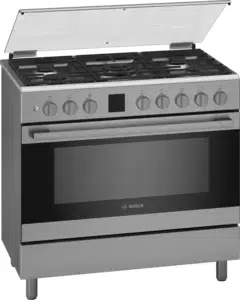Loading ...
Loading ...
Loading ...

20
Surfaces in the cooking compartment
The back wall and side parts in the cooking compartment are
self-cleaning. You can tell this from the rough surface.
The cooking compartment floor and ceiling are enamelled and
have smooth surfaces.
Cleaning enamelled surfaces
Clean the smooth enamelled surfaces with a dish cloth and hot
soapy water or a vinegar solution. Then dry with a soft cloth.
Soften baked-on food residues with a damp cloth and soapy
water. Use stainless steel wire wool or oven cleaner to remove
stubborn dirt.
Leave the cooking compartment open to dry after cleaning.
Note: Food residues can cause white deposits to form. These
are harmless and do not affect how the appliance works. You
can remove these residues using lemon juice if required.
Cleaning self-cleaning surfaces
The self-cleaning surfaces are coated with a porous, matte
ceramic layer. This coating absorbs and dispels splashes from
baking and roasting while the appliance is in operation.
If the self-cleaning surfaces no longer clean themselves
sufficiently and dark stains appear, they can be cleaned using
the cleaning function. To do this, refer to the information in the
relevant section.
Caution!
Do not use oven cleaner on self-cleaning surfaces. This will
damage the surfaces. If oven cleaner does get onto these
surfaces, dab it off immediately using water and a sponge
cloth. Do not rub the surface and do not use abrasive cleaning
aids.
Detaching and refitting the rails
The rails can be removed for cleaning. The oven must have
cooled down.
Unhooking the rails
1. Hold the bottom of the rail and pull it towards you a little. Pull
the extension pins at the bottom of the rail out of the
fastening openings (figure A).
2. Then pull the rail upwards and remove it (figure B).
Clean the rails with washing-up liquid and a sponge. Use a
brush to remove stubborn dirt deposits.
Hooking in the rails
1. Place the two hooks at the top of the rail into the upper holes.
2. Both hooks must be inserted fully into the upper holes. Now
move the rail down slowly and carefully and hook it into the
lower holes.
3. Hook both rails into the side walls of the oven.
Keeping the appliance clean
Always keep the appliance clean and remove dirt immediately
so that stubborn deposits of dirt do not build up.
Clean the cooking compartment after each use. This will ensure
that dirt cannot be baked on.
Always remove flecks of limescale, grease, starch and albumin
(e.g. egg white) immediately.
Use the universal pan for baking very moist cakes.
Use suitable ovenware for roasting, e.g. a roasting dish.
Appliance door
Appliance door
With good care and cleaning, your appliance will retain its
appearance and remain fully functional for a long time to come.
This will tell you how to clean the appliance door.
Detaching and attaching the oven door
For cleaning purposes and to remove the door panels, you can
detach the oven door.
The oven door hinges each have a locking lever. When the
locking levers are closed (figure A), the oven door is secured in
place. It cannot be detached. When the locking levers are open
in order to detach the oven door (figure B), the hinges are
locked. They cannot snap shut.
: Risk of injury!
Whenever the hinges are not locked, they snap shut with great
force. Ensure that the locking levers are always fully closed or,
when detaching the oven door, fully open.
Detaching the door
1. Open the oven door fully.
2. Fold up the two locking levers on the left and right (figure A).
3. Close the oven door as far as the limit stop. With both hands,
grip the door on the left and right-hand sides. Close the door
a little further and pull it out (figure B).
%
$
%$
Loading ...
Loading ...
Loading ...
